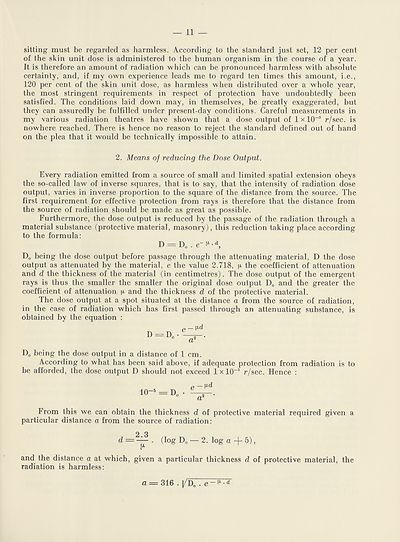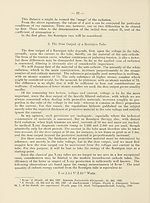Health > Protective measures against dangers resulting from the use of radium, roentgen and ultra-violet rays
(13)
Download files
Complete book:
Individual page:
Thumbnail gallery: Grid view | List view

— 11 —
sitting must be regarded as harmless. According to the standard just set, 12 per cent
of the skin unit dose is administered to the human organism in the course of a year.
It is therefore an amount of radiation which can be pronounced harmless with absolute
certainty, and, if my own experience leads me to regard ten times this amount, i.e.,
120 per cent of the skin unit dose, as harmless when distributed over a whole year,
the most stringent requirements in respect of protection have undoubtedly been
satisfied. The conditions laid down may, in themselves, be greatly exaggerated, but
they can assuredly be fulfilled under present-day conditions. Careful measurements in
my various radiation theatres have shown that a dose output of 1 x 10~s r/sec. is
nowhere reached. There is hence no reason to reject the standard defined out of hand
on the plea that it would be technically impossible to attain.
2. Means of reducing the Dose Output.
Every radiation emitted from a source of small and limited spatial extension obeys
the so-called law of inverse squares, that is to say, that the intensity of radiation dose
output, varies in inverse proportion to the square of the distance from the source. The
first requirement for effective protection from rays is therefore that the distance from
the source of radiation should be made as great as possible.
Furthermore, the dose output is reduced by the passage of the radiation through a
material substance (protective material, masonry), this reduction taking place according
to the formula:
D — D0 . e~ v-'d,
D0 being the dose output before passage through the attenuating material, D the dose
output as attenuated by the material, e the value 2.718, \i the coefficient of attenuation
and d the thickness of the material (in centimetres). The dose output of the emergent
rays is thus the smaller the smaller the original dose output D0 and the greater the
coefficient of attenuation m- and the thickness d of the protective material.
The dose output at a spot situated at the distance a from the source of radiation,
in the case of radiation which has first passed through an attenuating substance, is
obtained by the equation :
p _ |xd
D=D0. —F-.
a2
D0 being the dose output in a distance of 1 cm.
According to what has been said above, if adequate protection from radiation is to
be afforded, the dose output D should not exceed 1 x IQ-5 r/sec. Hence :
10-5 = D„
— (Jut
cr
From this we can obtain the thickness d of protective material required given a
particular distance a from the source of radiation:
d =— . (log D0
2. log a b),
and the distance a at which, given a particular thickness d of protective material, the
radiation is harmless:
a = 316 . ]/D0. e~^-d
sitting must be regarded as harmless. According to the standard just set, 12 per cent
of the skin unit dose is administered to the human organism in the course of a year.
It is therefore an amount of radiation which can be pronounced harmless with absolute
certainty, and, if my own experience leads me to regard ten times this amount, i.e.,
120 per cent of the skin unit dose, as harmless when distributed over a whole year,
the most stringent requirements in respect of protection have undoubtedly been
satisfied. The conditions laid down may, in themselves, be greatly exaggerated, but
they can assuredly be fulfilled under present-day conditions. Careful measurements in
my various radiation theatres have shown that a dose output of 1 x 10~s r/sec. is
nowhere reached. There is hence no reason to reject the standard defined out of hand
on the plea that it would be technically impossible to attain.
2. Means of reducing the Dose Output.
Every radiation emitted from a source of small and limited spatial extension obeys
the so-called law of inverse squares, that is to say, that the intensity of radiation dose
output, varies in inverse proportion to the square of the distance from the source. The
first requirement for effective protection from rays is therefore that the distance from
the source of radiation should be made as great as possible.
Furthermore, the dose output is reduced by the passage of the radiation through a
material substance (protective material, masonry), this reduction taking place according
to the formula:
D — D0 . e~ v-'d,
D0 being the dose output before passage through the attenuating material, D the dose
output as attenuated by the material, e the value 2.718, \i the coefficient of attenuation
and d the thickness of the material (in centimetres). The dose output of the emergent
rays is thus the smaller the smaller the original dose output D0 and the greater the
coefficient of attenuation m- and the thickness d of the protective material.
The dose output at a spot situated at the distance a from the source of radiation,
in the case of radiation which has first passed through an attenuating substance, is
obtained by the equation :
p _ |xd
D=D0. —F-.
a2
D0 being the dose output in a distance of 1 cm.
According to what has been said above, if adequate protection from radiation is to
be afforded, the dose output D should not exceed 1 x IQ-5 r/sec. Hence :
10-5 = D„
— (Jut
cr
From this we can obtain the thickness d of protective material required given a
particular distance a from the source of radiation:
d =— . (log D0
2. log a b),
and the distance a at which, given a particular thickness d of protective material, the
radiation is harmless:
a = 316 . ]/D0. e~^-d
Set display mode to:
![]() Universal Viewer |
Universal Viewer | ![]() Mirador |
Large image | Transcription
Mirador |
Large image | Transcription
Images and transcriptions on this page, including medium image downloads, may be used under the Creative Commons Attribution 4.0 International Licence unless otherwise stated. ![]()
| League of Nations > Health > Protective measures against dangers resulting from the use of radium, roentgen and ultra-violet rays > (13) |
|---|
| Permanent URL | https://digital.nls.uk/191800355 |
|---|
| Shelfmark | LN.III |
|---|---|
| Description | Over 1,200 documents from the non-political organs of the League of Nations that dealt with health, disarmament, economic and financial matters for the duration of the League (1919-1945). Also online are statistical bulletins, essential facts, and an overview of the League by the first Secretary General, Sir Eric Drummond. These items are part of the Official Publications collection at the National Library of Scotland. |
|---|---|
| Additional NLS resources: |
|

